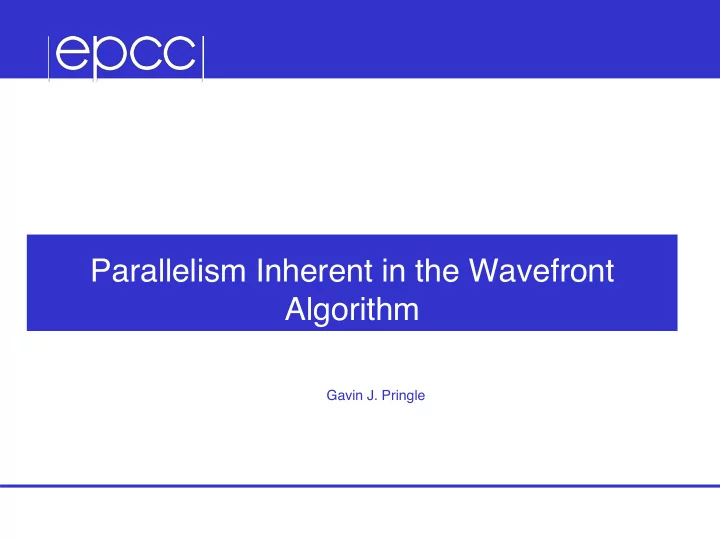

Parallelism Inherent in the Wavefront Algorithm Gavin J. Pringle
The Benchmark code � Particle transport code using wavefront algorithm � Primarily used for benchmarking � Coded in Fortran 90 and MPI � Scales to thousands of cores for large problems � Over 90% of time in one kernel at the heart of the computation 2
Serial Algorithm Outline Outer iteration Loop over energy groups Inner iteration Loop over sweeps Loop over cells in z direction Loop over cells in y direction Loop over cells in x direction Loop over angles (only independent loop!) work (90% of time spent here) End loop over angles End loop over cells in x direction End loop over cells in y direction �
Close up of parallelised loops over cells � Loop over cells in z direction Possible MPI_Recv communications Loop over cells in y direction Loop over cells in x direction Loop over angles (number of angles too small for MPI) work End loop over angles End loop over cells in x direction End loop over cells in y direction Possible MPI_Ssend communcations End loop over cells in z direction �
� MPI 2D decomposition is 2D decomposition of front x-y face. � Figure shows 4 MPI tasks l k j 5
Diagram of dependicies � This diagram shows the domain of one MPI task MPI data FromTop � A cell cannot be processed until all cells ���������������� been processed. MPI data ToLeft MPI data FromRight MPI data ToBottom 6
Sweep order: 3D diagonal slices MPI data FromTop Cells of the same colour MPI are independent and may data ToLeft be processed in parallel MPI data FromRight once preceding slices are complete. MPI data ToBottom 7
Slice shapes (6x6x6) Increasing triangles Then transforming Hexagons Then decreasing (flipped) triangles 8
Slice 1 Cell nearest the viewer 9
Slice 2 Moving down away from viewer 10
Slice 3 11
Slice 4 12
Slice 5 13
Slice 6 14
Slice 7 15
Slice 8 16
Slice 9 17
Slice 10 18
Slice 11 19
Slice 12 20
Slice 13 21
Slice 14 22
Slice 15 23
Slice 16 Point furthest from viewer 24
Close up of parallelised loops over cells using MPI � Loop over cells in z direction Possible MPI_Recv communications Loop over cells in y direction Loop over cells in x direction Loop over angles (number of angles too small for MPI) work End loop over angles End loop over cells in x direction End loop over cells in y direction Possible MPI_Ssend communcations End loop over cells in z direction �
Close up of parallelised loops over cells using MPI and OpenMP � Loop over slices Possible MPI_Recv communications OMP DO PARALLEL Loop over cells in each slice OMP DO PARALLEL Loop over angles work End loop over angles OMP END DO PARALLEL End Loop over cells in each slice OMP END DO PARALLEL Possible MPI_Ssend communcations End loop over slices �
Parallel Algorithm Outline Outer iteration Loop over energy groups Inner iteration Loop over sweeps Loop over slices Possible MPI_Recv communications OMP DO PARALLEL Loop over cells in each slice OMP DO PARALLEL Loop over angles work End loop over angles Etc
Decoupling inter-dependant energy group calculations � Initially, each energy group calculation used a previous energy groups results as input � Decoupling the energy groups has two outcomes � Execution time is greatly increased � Energy Groups are now independent and can be parallelised � Often seen in HPC � Modern algorithms can be inherently serial � An older version may be parallelisable
TaskFarm Summary � If all the tasks take the same time to compute � Block distribution of tasks � Cyclic distribution of tasks � ��������������� � else if all tasks have different execution times � If length of tasks are unknown in advance � Cyclic distribution of tasks � else � Order tasks: longest first, shortest last � Cyclic distribution of tasks � endif � Endif
Final Parallel Algorithm Outline Outer iteration MPI Task Farm of energy groups Inner iteration Loop over sweeps Loop over slices Possible MPI_Recv communications OMP DO PARALLEL Loop over cells in each slice OMP DO PARALLEL Loop over angles work End loop over angles Etc
Conclusion � Other wavefront codes have the loops in a different order � Loop over energy groups can occur within loops over cells and might be parallelised with OpenMP � Must be decoupled
Thank you � Any questions? � gavin@epcc.ed.ac.uk
Recommend
More recommend